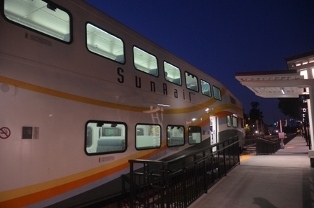|
SunRail Users Likely To See Health Benefits  Potential freedom from I-4 might be the single biggest cause of excitement surrounding SunRail. But SunRail offers us more than an escape from gridlock. It offers the chance to live in healthier communities.
[Florida Hospital worked to ensure that the nearby SunRail station was attractive to pedestrians] The sound of the train is just part of life in Winter Park. And for that reason- Winter Park is positioned to be a healthy community standout among SunRail locations. “That whole area is walkable, because it was laid out around the train station many many many years ago. It developed in a very different way. It’s a very inviting environment, people enjoy going there,” he says. MetroPlan Orlando Executive Director Harry Barley says commuter rail can bring a number of health benefits to the surrounding community. Casselberry resident and Florida Hospital Nurse Trainer Alicia Kleinhans says she’s been planning to use SunRail to avoid I-4. It wasn’t until the hospital hosted a SunRail open house that she realized the potential health benefits. She says the train will knock a significant amount of time off her commute, which means more time to work out. “Plus, the train station is only about 3 and a half miles from my house, so that’s a very doable bike ride. I was very excited when I found out they actually have space on the train where you can put your bike,” she says. Barley says the areas surrounding both Orlando Health and Florida Hospital are both likely to see increased pedestrian traffic. Florida Hospital CEO and President Lars Houmann says that’s in line with the hospital’s mission to help create a healthy community- and was important enough that the hospital invested its own money into building a pedestrian friendly station. “What we’ve done here is to create an urban environment with wide sidewalks, approachable store fronts, reasons to be on the street,” he says. Houmann says Florida Hospital made the investment because it wants its Health Village’s 8000 employees to use SunRail. It’s even helping hospital employees pay for passes. But SunRail could turn out to be a good thing for patients too. “I think it makes a lot of sense, particularly for outpatients and people that have on-going procedures and things that they’re coming back for,” he says. SunRail was the subject of the Mayor’s remarks at a recent event promoting walking at the Maitland Center Business Complex. Howard Scheifferdecker says an estimated 17-thousand people commute into the Maitland Center for work- but the Maitland Center isn’t really close to the city’s SunRail station. “If the final mile gets everybody to their destination in an efficient basis, a timely basis, it will be a big success,” he says. The final mile for the Maitland Center might mean company shuttles for some. The distance is easily handled by bicycle- something the city of Orlando is looking at for some of its final mile issues. Harry Barley says bike sharing pilot programs popping up in Central Florida not only address the final mile- they up the healthy community quotient. “The city of Orlando is about to implement a pilot project, UCF has a pilot project, Winter Park library has a few bikes parked outside with help from a grant from Health Central Florida, but this is something new, this is something different and it’s going to take a while for it to catch on,” he says. Another element in a health community is a strong sense a place- which again- the city of Winter Park already has in its favor. But Barley says station locations that have no identity right now- blank canvasses so to speak- could see SunRail become the community anchor. He says a recent SunRail event at the Orange Ave/Sand Lake road station is perfect example. “2000 people showed up. It was a huge event down there. Tremendous excitement about this. And that’s being a blank canvas,” he says. So maybe we’ll see examples of new urbanism springing up around some of our SunRail stations- similar to the way towns like Sanford and Winter Park originally developed, but with a modern and potentially healthier twist. |
|
|